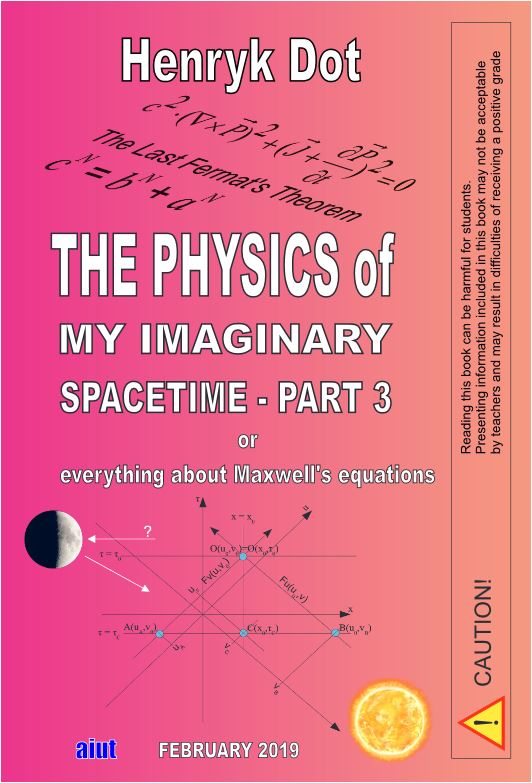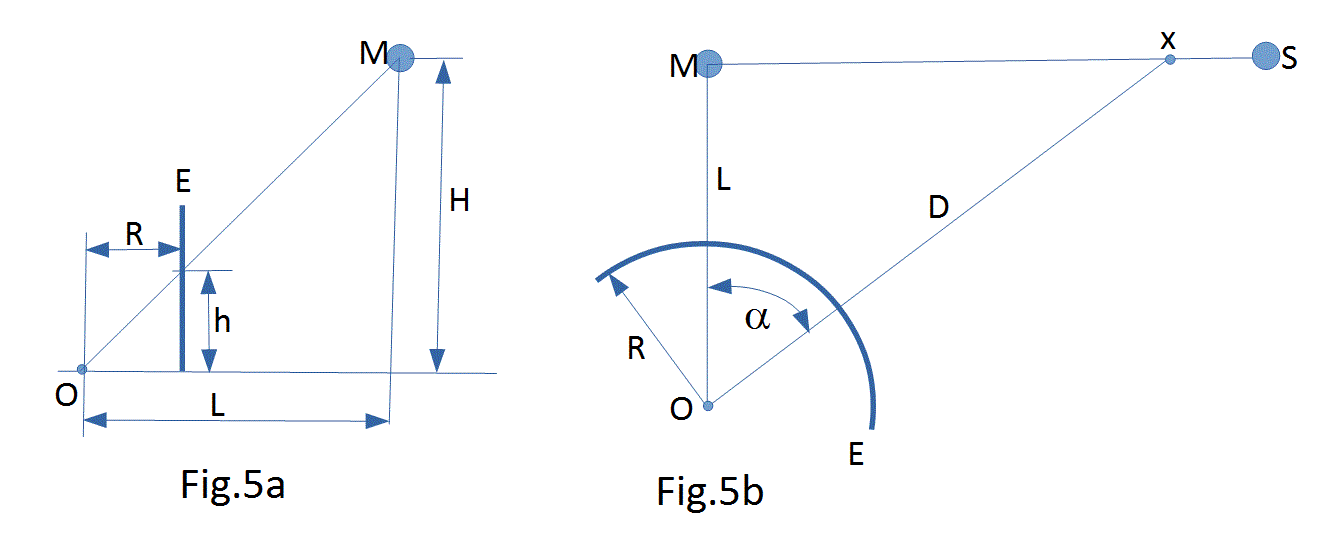is the online companion to a series of books published by AIUT under the common main title
"Physics of My Imaginary Space-Time" by Henryk Dot.
Physics 3 - Maxwell
Note from the Author
Table of Contents
What is this book
Historical facts
New aspects
Fully erroneous
Incorrectly interpreted
Physics 3 - Chapter 1
Equations
Complex vectors form
The Most General form
The General Solution
Physics 3 - Chapter 2
Solutions
Initial conditions
Non-homogeneous equation
Solution for three-directions
The four laws
Physics 3 - Supplement
Fermat's proof
Beal's conjecture
Pythagorean triples
Inertial mass
Gravity constans big G
What does the Moon look at?
Physics 3 - Final notes
Final notes
Physics 4 - New book
Entry
"Subject" should begin with
a digit corresponding to the day
of the week., e.g. Sunday=7
Books published by AIUT
are found in libraries according to the list of compulsory copies.
Second Edition of "Fizyka 3"
ISBN 978-83-926856-1-6

can be bought in Warsaw
in the Academic Bookstore
PW Publishing House
Noakowskiego street 18/20
and in Katowice
in the bookstore "Liber"
Bankowa street 11.
(area of Silesian University)
English edition of "Physics"
ISBN 978-83-926856-2-3

is also in libraries
and the distribution method should be asked wydawca@aiut.com.
|
3.4. Why the Moon in first and last quarter phase when the Moon is high above the horizon, and the Sun is low or even below the horizon (but its edge can still be seen). The Sun is not located on the line which is perpendicular to the straight-line separating shadow from lit part of the Moon. In order to observe this, we don’t have to wait for specific date when this quarter phase occurs, and the sky is cloudless. This can be observed as well in planetarium, which I personally verified (Silesian Planetarium in Chorzow, Poland). I shared my observation with editorial office of Polish astronomical magazine URANIA. They inquired about publishing my letter along with their explanations in a future issue of the magazine. I willingly accepted since I sent my letter to popularize this phenomenon, but I also suggested that full explanation should be published, not only the cause. I also advised that I was writing a book and I was planning to put full explanation in it. However, if their magazine publishes adequate explanation, I will just include in my book only the reference to the magazine. The explanation should include drawing or photograph where sunrays path to the Moon is marked. However, the explanation published in the URANIA issue 3/2014 (page 65) has not satisfied my expectations. Therefore, my full explanation is included in here and you as a reader should be able to decide which one you like better. To begin with, this phenomenon is known to children in elementary school where in art class they have to draw utility poles or fences in perspective. For a fence going across the page we show the same height, while for a fence going “away” the height is getting smaller and smaller on a drawing. We have both of these effects at the same time in our problem with the Moon. When looking at the Moon, it is like looking at a fence going across drawing. However, when looking at the Sun, we turn around involuntarily and we see going “away” fence. We can illustrate this situation by following example: we are standing in a room and there is a picture of the Moon on the wall in front of us, and on the wall to the right the picture with fragment of the Sun. If we direct our sight to the edge between these two walls, we will see the image depicted on Fig.5.  Even though this drawing is simply on elementary school level, it can still depict the angular difference between real and apparent sunrays. In order to illustrate sunray path to the Moon - let’s assume that we connect Sun and Moon by rigid pipe. It is obvious that sunrays reaching the Moon must travel inside this pipe. Practically, due to the big difference in diameters of these bodies, sunrays will be as beveled cone shape, but at the same time we have a significantly big distance between them, so it would look like a fixed diameter pipe. Our task is to answer the question: “How this “pipe” would look like on a photograph? Firstly, we will take a panoramic sky photo, that is we will transpose an image of sky sphere onto cylindrical vertical screen E placed around an observer – this is illustrated on drawings below.  Figure 5a illustrates a plane crossing through the Moon and vertical plane of an observer O. Figure 5b illustrates a plane perpendicular to vertical direction of an observer and this is our reference plane. During first quarter the angle OMS is 90 degrees. The line MS (Moon-Sun) represents “fence” which height is H, at the distance of L. The image of the Moon M on cylindrical screen E (cylinder radius = R) is located at the height: |
|
| |
(3.23) |
|
The distance D to the point x in our “imaginary fence” is equal to: |
|
| |
(3.24) |
|
The point x on the screen E corresponding to the top of the “fence” is located at the height: |
|
| |
(3.25) |
|
We can see that on flatly spread screen E, the axis of the “pipe” connecting the Moon and | |
© 2020 Henryk Dot -
